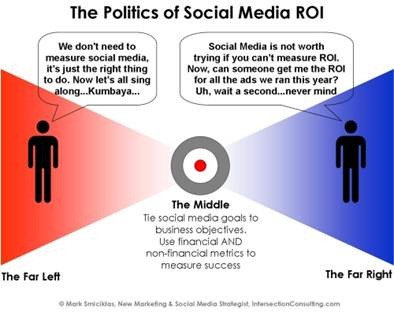Social Media ROI – Can you measure it fully?
Most of the businesses realize the Social Media Benefits, however how much to spend and its trade-off with money is debatable. Infact, finding return on investment (ROI) itself is a tough job. Let us look at it a little closer.
Worried about Social Media ROI?
Returns on investment are measured in monitory terms most of the times. Marketers usually measure it as Net present value of stream of revenues vs monitory expenditure.
In terms of percentage it is
ROI= [(Amount Gained from Investment – Cost of Investment)/Cost of Investment] x 100
ROI of Social Media doesn’t change much in its definition. After all, a business is a business is a business. It must earn more than it spends. However, most of the times Net Present Value of revenues is difficult to measure when it is Social Media, mainly because it revolves around Brand Awareness and conversations more than anything else.

I recommend Social Media ROI written by Olivier Blanchard, after reading which I am sharing my views through this post. I do not agree to some of author’s ideas, but let’s take up some interesting and debatable part of the book.
Many companies fear that there’s no true way to measure the ROI of social media activities. In comparison to other marketing channels such as e-mail, SEO, and display advertising, social media doesn’t offer a very direct or concrete ROI measurement.
This is partly due to the fact that social media interactions revolve mostly around online conversations, which are not as easy to measure quantitatively as click-throughs and CPMs. Because social media is very much about the qualitative and not quantitative, this result in much debate about what metrics are truly useful and accurate when it comes to social media marketing.
Just because measuring social media ROI is a challenge doesn’t mean it’s impossible. The world of social media ROI is still evolving. We may have to rethink traditional metrics to include the ways that people interact with social media. The measurement of returns through social media isn’t done the mathematical way!
For example, the standard metrics for e-mail marketing include delivery, open and click-through rates. While it’s still possible to find value in measuring click-throughs from specific URLs on sites such as Twitter or YouTube, social media also lends itself to new categories of measurement, such as activity and engagement.
Now, how can we measure engagement? Let’s consider engagement to be a category of interaction that includes posts/threads, comments, tags, votes, bookmarks, and more. This can be done quantitatively (for metric lovers); however categorizing them under positive, negative and neutral heads makes more sense before we could realize the returns. This accounts for qualitative measures where extent of positive conversations should outnumber the negative and neutral. Viral content is a blessing!
Another important area of measurement for social media is brand awareness. Traditional media might measure brand and awareness through reach and frequency: how many people have seen an ad and how many times they’ve seen it. For Social Media, there are technologies that measure posts for positive and negative sentiments, and which measure “share of voice” (i.e. the number of articles, tweets, posts, etc. in which a specific brand is mentioned in comparison to its competitors).
Although the world of social media brings with it new ways of measuring activities and interactions, the traditional ROI metrics of revenue – cost savings, conversions, cost per lead, etc.– are still what matters when it comes to proving the value of your social media marketing initiatives. Try categorizing leads into Inbound Vs Outbound leads to start measuring returns.
An inbound lead may get to know about your business via Tweet, then read your blog, and later contact you via email. Therefore, try not to get more granular that Inbound leads as it will add up to time and efforts.
By establishing a baseline and measuring progress over time, companies can begin to see the effects of social media on growth and revenue.
Whats your take on this ?

Thanks for appreciating Vikas.. :)
Excellent overview, it pointed me out something I didn’t realize before. I should encourage for your wonderful work. . I am hoping the same best work from you in the future as well. Thank you for sharing this information with us.